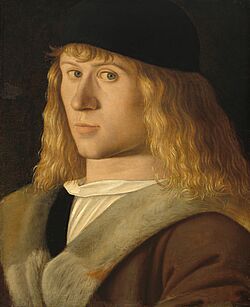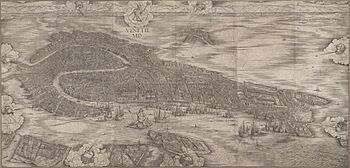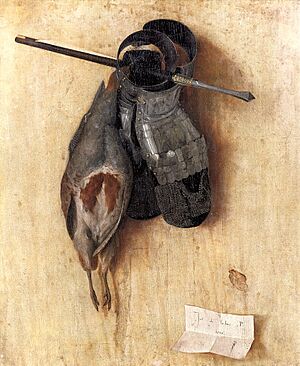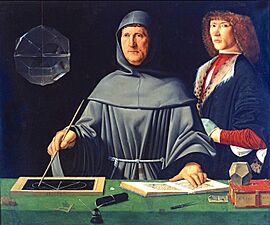Jacopo de' Barbari facts for kids
Quick facts for kids Jacopo de' Barbari |
|
|---|---|
 |
|
| Year | 1505 |
| Location | National Gallery of Art, Washington, D.C. |
Jacopo de' Barbari (born around 1460/70, died before 1516) was a talented Italian painter, printmaker, and artist who created tiny pictures. He had a very unique style. In 1500, he moved from Venice, Italy, to Germany. This made him the first important Italian Renaissance artist to work in Northern Europe.
Only about twelve of his paintings still exist today. One of them is the first known example of trompe-l'œil since ancient times. Trompe-l'œil is a French term that means "deceive the eye." It's an art technique that makes flat images look like real, three-dimensional objects. His twenty-nine engravings and three very large woodcuts were also very important and influenced many other artists.
Contents
His Life Story
We don't know exactly when or where Jacopo de' Barbari was born. People at the time, like the famous artist Albrecht Dürer, said he was from Venice. In 1511, he was described as 'old and weak,' so he was likely born between 1460 and 1470. Some people thought he might have been born in Germany and then moved to Italy, but this is just a guess.
He signed most of his engravings with a caduceus. This is a symbol of Mercury, the Roman god of messages and trade. On one of his paintings, the Still-Life with Partridge and Gauntlets, he signed "Jac.o de barbarj p 1504". He probably wasn't part of the famous Barbaro family in Venice.
We don't know much about his early life or who taught him. Some think he might have learned from Alvise Vivarini. In 1500, he left Venice and went to Germany. After that, we have more information about his life.
Working for Kings and Rulers
In Germany, Jacopo de' Barbari worked for Emperor Maximilian I in Nuremberg for about a year. Then, from 1503 to 1505, he worked for Frederick the Wise of Saxony. After that, he moved to the court of Elector Joachim I of Brandenburg from about 1506 to 1508. In Germany, people often called him "Jacop Walch," which probably meant "foreigner" because he was Italian.
He might have gone back to Venice with Philip the Handsome of Burgundy. Later, he worked for Philip in the Netherlands. By March 1510, he was working for Philip's successor, Archduchess Margaret, in Brussels. In January 1511, he became very ill and made his will. In March, the Archduchess gave him money for life because he was old and weak. He died by 1516. He left twenty-three engraving plates to the Archduchess.
His Artworks

The Famous Map of Venice
One of his earliest known works is a huge and amazing woodcut map called Map of Venice. It measures about 1.3 meters by 2.8 meters and was made from six different wood blocks. A special permission for its printing was given in 1500, and it said the map took three years to make. This map showed an aerial view of Venice and was a huge achievement. It caused a lot of excitement when it was first released. Later, others updated the map to show new buildings that had been built.
Besides the Map of Venice, he made two other large woodcuts. These showed men and satyrs (mythical creatures that are part human and part goat). These were the biggest and most impressive pictures made from woodcuts at that time. They helped start a tradition of creating beautiful, large woodcuts in Italy for many years. These might have also been made before 1500 and were clearly influenced by the artist Andrea Mantegna.
One of these, "Triumph of Men Over Satyrs," shows scenes after a battle. Men and women walk towards a temple, carrying defeated satyrs as prisoners in baskets. This print might be connected to another woodcut called "Battle Between Satyrs and Men."
Meeting Albrecht Dürer
When the Map of Venice was printed, Jacopo de' Barbari had already moved to Germany. There, he met Albrecht Dürer, another famous artist. They might have known each other from Dürer's first trip to Italy. They talked about human proportions, which is how the parts of the human body relate to each other in size. Dürer was very interested in what de' Barbari had to say, even though de' Barbari didn't share all his secrets.
Dürer wrote: "I find no one who has written anything about how to make canon of human proportions except for a man named Jacob, born in Venice and a charming painter. He showed me a man and a woman which he had made according to measure... Jacobus did not want to show his principles to me clearly, that I saw well."
Twenty years later, Dürer tried to get a book about human proportions that de' Barbari had written. The book belonged to Archduchess Margaret, but Dürer couldn't get it, and the book is now lost.
When His Art Was Made

Jacopo de' Barbari lived in Nuremberg, where Dürer lived, from 1500 to 1501. Both artists influenced each other for several years. None of de' Barbari's engravings have dates on them. So, experts often guess when they were made by comparing them to Dürer's dated prints. This can be tricky because it's sometimes hard to tell who influenced whom.
Some of his paintings have dates: 1500, 1503, 1504, and 1508. Records show that he was supposed to decorate books with tiny pictures, but no works like that are definitely known to be his. His only widely accepted drawing is a picture of Cleopatra in the British Museum. It was probably a study for an engraving that no longer exists.
Engravings and Their Style
Jacopo de' Barbari's style is similar to his possible teacher, Alvise Vivarini, and to Giovanni Bellini. But his art has a dreamy, relaxed quality that is all his own. Besides Dürer, the way Andrea Mantegna made prints also influenced de' Barbari. This can be seen in his earlier engravings, made around 1500, which use parallel lines for shading. His engravings are usually small and show only a few figures.
He often included grumpy satyrs in his prints. He also created several pictures about myths, including two called Sacrifices to Priapus. His earlier prints show figures with "small heads and somewhat shapeless bodies, with sloping shoulders and thick torsos supported by slender legs." This can also be seen in his paintings.
Later, his ability to arrange the whole picture improved greatly. In his last group of prints, his style became more Italian. The pictures became more complex and had a mysterious, haunting feeling, with very detailed techniques. Some experts think these were made when he was in the Netherlands and were influenced by the young artist Lucas van Leyden. Art and trade often traveled between the Netherlands and Venice because both were busy port cities.
His Paintings

Jacopo de' Barbari's paintings are mostly portraits or religious scenes with figures shown from the waist up. He painted a live Sparrowhawk (now in the National Gallery, London), which is probably a piece of a larger painting.
His very early still-life painting, Still-Life with Partridge and Gauntlets (in Alte Pinakothek, Munich), is often called the first small trompe-l'œil painting since ancient times. It might have been the cover or back of a portrait. In the Gemäldegalerie, Berlin, there is a Portrait of a German Man and a religious painting by him. The Louvre museum has a religious group of figures, and a museum in Philadelphia has a pair of figures.
A famous painting, the Portrait of Fra Luca Pacioli, is in the Museo di Capodimonte in Naples. Some people think de' Barbari painted it, but others are not sure. This painting shows a Franciscan mathematician and expert on perspective named Luca Pacioli. He is demonstrating geometry at a table. On the table are his own book, Summa, and a book by Euclid. He is with a student who isn't clearly identified. The painting is signed "IACO. BAR VIGEN/NIS 1495". Jacopo de' Barbari is also believed to have painted a Christ Blessing at the Snite Museum of Art in Indiana.
See also

